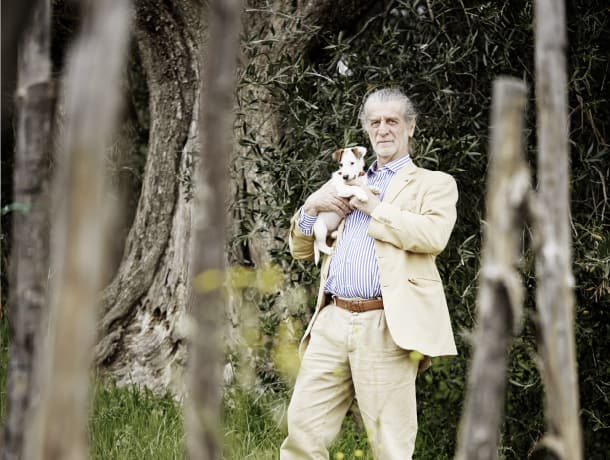17/07/2015

Francesco Illy ha piantato Sangiovese a densità superiore a 25.000 ceppi per acro per il suo ricercato Bonsai Rosso di Montalcino.
Francesco Illy has done many things for love.
In Montalcino, his muses have been art, wine and a woman.
Illy, 62, is the eldest son of the third generation of Italy’s high-end espresso clan. A professional photographer, he is also considered the family’s eccentricartista.
In 1987, he was shooting the interior of the New York Italian restaurant Palio, known for its stunning murals painted by Italian artist Sandro Chia. “I fell in love with Sandro’s art,” says Illy, his blue eyes shining brightly, not looking the part of an Italian industrial scion in his rumpled red wool jacket, scraggly white beard and ponytail.
Illy befriended Chia, who invited him to stay at his highly regarded wine estate,Castello Romitorio, near Montalcino.
Illy fell for the landscape and began thinking of buying his own place. He found it 10 years later when Chia’s winemaker, Carlo Vittori, called about a farm being sold by a retiring shepherd.
In 1998, Illy bought Podere Le Ripi—130 acres that include forests, olive groves and loam, clay and limestone slopes ideal for vineyards. With a long appreciation of wine benchmarks such as Gaja, Giuseppe Mascarello and Domaine de la Romanée-Conti to inspire him, he started planting two years later, about 5 acres of Sangiovese at first. In 2003, he began producing a Brunello di Montalcino called Lupi e Sirene.
All might have gone smoothly from there, but Illy developed another obsession: plant density.
“When I started,” Illy says with an easy laugh, “I was a cazzo di vino.” That politely translates as: “I didn’t know what I was doing.”
But in his travels he learned that densely planted vineyards force vine roots downward through soil layers and make for more complex wines. “So I said, ‘Why don’t I make the densest vineyard in Montalcino?”
Area growers consider 5,000 vines per hectare (2,025 per acre) to be optimal. In 2003, Illy planted 11,000 vines on 1 hectare.
Two years later, on a trip to Burgundy, he was devastated when a winemaker told him he couldn’t make a great wine with vines younger than 35 years.
“I didn’t want to wait until I was 90 years old to make a good wine!” Illy says. “So I thought, ‘Why don’t I do something ridiculous and plant the vine so densely the roots will have to go down or die?'”
That same year, Illy planted an experimental quarter-acre at an unheard-of density of 62,500 vines per hectare. The vines were placed 16 inches apart and tied to bamboo sticks, for an effect resembling a Japanese garden.
Remarkably, with no irrigation, the vineyard survived with few casualties as the roots worked into the soils. Illy says the vines suffer less from summer heat stress and produce his best grapes—at Lilliputian yields of two bunches per plant.
With the 2007 vintage, he released the first results, called Bonsai—600 bottles of Rosso di Montalcino aged in barrel for three years. That’s perhaps the most babied and, at about $135, priciest Rosso di Montalcino, a wine generally released earlier and less expensive than Brunello. “When you make Sangiovese well,” Illy says he has learned, “it’s one of the most beautiful things in the world.”
Since the introduction of Bonsai, Illy has continued to experiment and expand. He has continued with more “bonsai” plantings and expects to harvest an additional 2.5 acres of Sangiovese this fall so he can increase production of the hard-to-find wine. He converted Podere Le Ripi’s 33 acres of vineyards—which include Syrah and Merlot along with the Sangiovese—to biodynamic farming beginning in 2010.
In 2008, Illy convinced his brothers to buy the highly noted Mastrojanni estate next door, and he serves as its president.
And Podere Le Ripi’s new winery is in its final stages. Designed by Illy’s architect son, Ernesto, the structure is a spiral with descending ramps (à la New York’s Guggenheim museum) with a soaring central oculus (like Rome’s Pantheon) for its aging cellar. The building has no straight lines, and it’s taken four years for masons to lay 1 million bricks proportioned according to the “golden ratio”—a mathematical relationship, studied since at least ancient Greece, that is synonymous to some artists and architects with harmony.
“If it brings me harmony, I’ll take it,” Illy says. “If it doesn’t … at least I have a beautiful story to tell.”
Prenota una visita
Compila il form e ti contatteremo presto!